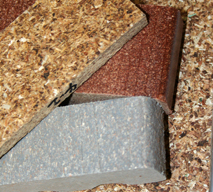By Allison Sansom

Greg Holt with gin trash briquettes.
Gin waste usually is thought of as anything but a treasure, consisting of residue from the cotton plant such as immature seed, sticks, leaf, short fiber lint, and sand. However, the future looks bright for cotton gins having problems disposing of gin waste as more and more uses are being found for the product.
Research being conducted at the Cotton Production and Processing Research Unit in Lubbock, Texas, was spurred by a 1998 survey by the Texas Cotton Ginners Association. The survey asked the ginners to list their top 10 concerns, and gin waste was number two on the list.
Once the gin waste is collected by the gins, processing the biomass begins. Processing includes separating, grinding, and sterilizing the gin waste. USDA Agricultural Engineer Greg Holt says it is imperative that the gin waste be sterilized in order to rid the mixture of weed seed and fungus. The coarse pieces of lint, leaves, stems, burrs, and other field debris turn into a product that looks like finely ground garden mulch. This product can be further processed into manufactured goods such as pellets for fuel, livestock feed, or a mulch that can be mixed with other plant nutrients. It also can be compressed into building products.
By turning cotton gin by-products into mulch, Holt’s objective is to evaluate new recipes of cotton-based hydromulch using a new process versus commercially available erosion control blankets for use on steep slopes. He also is comparing moisture retention and grass establishment of various hydromulches and erosion control blankets.
 Through many studies, Holt has found that cotton-based hydromulch significantly reduces erosion compared to conventional hydromulch products currently made from wood or paper. Other studies show some recipes of cotton- based hydromulches dramatically enhance grass growth and soil moisture retention while conventional hydromulches did not greatly improve grass growth or moisture retention.
Through many studies, Holt has found that cotton-based hydromulch significantly reduces erosion compared to conventional hydromulch products currently made from wood or paper. Other studies show some recipes of cotton- based hydromulches dramatically enhance grass growth and soil moisture retention while conventional hydromulches did not greatly improve grass growth or moisture retention.Holt estimates that there are more than 2.25 million tons of cotton gin by- products produced each year in the United States, and he has been trying for years to determine the best use for the biomass. It has been difficult, but Holt now believes hydromulch is a promising solution.
“The process of turning gin trash into mulch is comparable to the cost of producing a high quality hydromulch from wood,” Holt said. “We use equipment for chopping, shredding, coloring, and bagging, and we’re competitive with other mulch products.”
Holt says processing is not particularly complicated, but quality control is necessary to prepare the correct texture, size, blend of gin waste and other biomasses, and sanitation. Holt is working with several machines to determine the best processing procedure. Now, the team uses commercially available equipment set up to obtain the desired characteristics of the erosion control product being produced.
Leggett & Platt and Mulch and Seed Innovations are two companies Holt works with in trying to find the right combination for the best  mulch. Both companies are working to develop the technology in an effort to use cotton’s natural strengths as a base for hydromulch and other landscaping products. Knowing that cotton is naturally porous, absorbent and easily biodegradable, Holt, along with cooperators like Cotton Incorporated and the companies listed above, took these characteristics and found the perfect foundation for nurturing seed and controlling erosion.
mulch. Both companies are working to develop the technology in an effort to use cotton’s natural strengths as a base for hydromulch and other landscaping products. Knowing that cotton is naturally porous, absorbent and easily biodegradable, Holt, along with cooperators like Cotton Incorporated and the companies listed above, took these characteristics and found the perfect foundation for nurturing seed and controlling erosion.
Holt says hydromulch material typically mixes one pound of material to two gallons of water. With gin waste, the ratio is one pound to one gallon. This is possible because cotton absorbs and holds water which improves pumping ability. When using an air sprayer, gin waste mulch can be applied with one pound of material and one ounce of water.
Briquettes were made in an effort to make the densification process simpler and less labor intensive than it is with pellet mills. Briquetting has made handling and transportation of gin waste easier for use in commercial applications. Boilers and heaters, where briquettes are burned, are designed to use fuel in solid form and operate better when the products are densified. A briquetter, the equipment used to make briquettes, has less specialized parts and is easier for gin personnel to repair and maintain than a pellet mill.
The briquettes are going to be available commercially in 2008 for use in industrial applications. Approximately 50 to 75 percent of the gin trash biomass could be used in making briquettes.
The segregation and sizing of the plant materials are really the key components to successfully utilizing cotton gin by-products,” Holt said.
According to decaturdaily.com, gin trash also could be used to produce ethanol. Decatur chemical engineer and entrepreneur Brian Baer wants to build a plant that will be able to turn gin trash into ethanol in less than 72 hours. The gin trash ethanol could be mixed with gasoline, or used alone, for fuel in vehicles.
Baer is located in the South where there is an abundant supply of cotton gin trash. There are approximately 512 gins in the area and each produce an average of 2,500 tons of gin trash per year. Baer said that is enough to produce 60 million gallons of ethanol each year. He explained that gin trash is a good product to use in ethanol production because it is not in competition with other commodities such as corn, soybeans or sugar beets which also are used for human consumption.
The use of gin waste in hydromulch, building materials, ethanol, and other items demonstrates how improvements in technology can transform what once was a disposal problem into a potential revenue stream utilizing an overlooked renewable resource.


